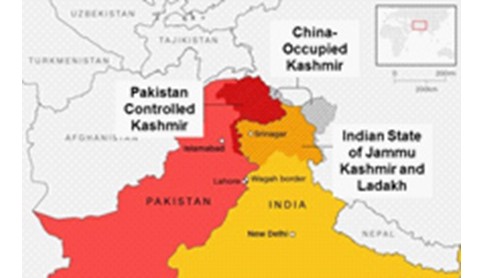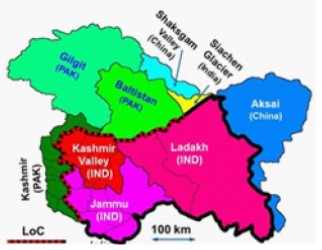By Kollengode S Venkataraman
The complex history of Kashmir from all perspectives is scattered throughout cyberspace. Atul Singh and Manu Sharma’s recent summary What Lies Behind India’s Bold Bet on Kashmir? in the on-line magazine Fair Observer is an example.

Pakistan does not even recognize Articles 370 and 35A of the Indian constitution, which, in 1954, gave special status as a temporary measure to India’s Jammu & Kashmir (J&K) state after its accession in the 1947 Partition. In 1947, when Kashmir’s king Hari Singh joined with India, Pakistan sent its forces and took control of part of Kashmir. The maps below show how Kashmir is split among India, Pakistan, and China, with the former two claiming the whole of Kashmir. The Line of Control (LoC) is the current de facto border.

To begin with, the two articles in the Indian constitution, included as temporary measures, are discriminatory Women face disparities in property and marriage rights vis-a-vis men. There is no constitutional protection for the Scheduled Castes and Scheduled Tribes and minorities. Indians are prohibited from a) claiming residency in the state no matter how long they have lived there, b) acquiring property, c) getting assistance from government programs, and d) securing government jobs and scholarships for children in colleges.
These factors and the continual violence, particularly in the Kashmir Valley, has not helped in developing the region in the last thirty years, compared to the rest of India. But as happens with any government, once you put any rule to suit the need of the hour, vested interests take over, making it impossible to change them.

In the meantime, Kashmiris have spread out all over India establishing themselves, buying properties, running businesses, educating their children, and getting all the other benefits of the Indian citizenship.
The Kashmir issue is the “jugular vein†for its military and its politicians. So, Pakistan tries to “internationalize†India’s August 5 abrogation of Articles 370 and 35A, even though it does not even recognize them. Pakistan’s military has perpetuated its iron grip on Pakistan’s government and resources, penetrating Pakistani society through the thousands of businesses the military runs. So, India as an eternal threat is necessary for the military to continue its hold on Pakistan’s civil society.
In the politics of the J&K state since 1947, only a few families have had influence and control: the Abdullahs (Sheikh, his son Farookh, and Farookh’s son Omar); the Muftis (Mohammed Sayeed Mufti and his daughter Mehbooba); the Lones and the Ansaris; and finally, the Nehru/Gandhi family’s satraps. Corruption in public life in any system with only a handful of families having power for generations needs no explanation. This is endemic throughout India.

Given the pre-British bloody history of the region and how India and Pakistan violently sliced the region between themselves during Partition, it is impossible to mediate an acceptable solution. On Kashmir, there are more than two parties — the governments of India and Pakistan, Pakistan’s military, hardliners in each country, Kashmiri separatists, and then, China. So, the ulcerous issue has festered for over 70 years.
The British colonial occupiers left India in reckless haste in 1947, letting the “native coolies†fend for themselves and sort out the issues. If they thought that the ensuing confusion and violence would keep their influence and control on the natives, they were mistaken. Over the past 70-plus years, all options have been tried to resolve the issue:
a) Pakistan-initiated outright wars in 1965, 1971 and 1999; continual stealth operations by Pakistan across the LoC and in the Kashmir valley through the decades; and providing “political, moral, and diplomatic†support (which means providing arms, money and intel) for the Kashmiri separatists and terrorists; b) hyped up summitry between the India-Pakistan heads of governments, secret back channel contacts between government-approved interlocutors; c) soft power people-to-people contacts, sports and cultural exchanges, and train and bus services across the border; d) improving trade that will obviate the very idea of “borders†in the globalized world; e) nuclearization of the region with tens of atom bombs by India and Pakistan (and China) with sophisticated delivery systems with historically ominous names (Pakistan’s Ghauri, Gaznavi, Abdali, and Babur missiles). But nothing has worked.
President Trump’s unsolicited, gratuitous mediation offer was the tipping point. In diplomacy, Trump is as nuanced as a wild raging bull in a china shop. So, nobody took seriously the unsolicited mediation offer — not to mention the arbitration offer — he flippantly and irresponsibly threw at TV reporters when Pakistan’s Prime Minister Imran Khan visited the White House last July. The unsolicited offer Trump made was lapped up by Pakistan as a game changer in this intractable issue. In a way, it indeed was, but not in the way Pakistan wanted. India never wasted time in saying publicly “Thanks Mr. Trump, but no thanks.†Later, with Trump at his side at the G-7 meeting in France in August, Modi declared that all India-Pakistan issues “are bilateral†and will be resolved bilaterally.
In India all political parties, in principle, have committed to scrap the Articles, which were, after all, temporary measures. The Congress Party has been whittling down their provisions over the years. For the Bharatiya Janata Party (BJP), scrapping the articles was a public declaration. The BJP returned to power in the May 2019 elections with even a greater majority than what it got in 2014. In public discourse, this has been debated ad nauseam. Besides, as reported by TCA Sharad Raghavan in The Hindu, (July 24, 2016),
“Jammu and Kashmir [alone] has received 10 per cent of all Central grants given to states [during] 2000-2016, despite having only one per cent of the country’s population… … In contrast, Uttar Pradesh [with] about 13 per cent of the country’s population received only 8.2 per cent of Central grants in 2000-16. That means J&K, with a population of 12.55 million according to the 2011 Census, received Rs.91,300 per person over the last sixteen years while Uttar Pradesh only received Rs.4,300 per person over the same periodâ€
The Modi government saw the atmosphere was ripe (see the article below) for scrapping J&K’s temporary special status. So, on August 5, it moved resolutions in both houses of the parliament scrapping the two 70-year old articles from the Indian constitution. In doing so, it incorporated Jammu and Kashmir as a federally administered area with its own elected legislative body; and the Ladakh/Kargil region, to be directly administered by the Federal government in Delhi. n
The Timing of the Decision
In politics, timing is everything for bringing about far reaching, fundamental changes. Just consider these factors the Modi government would have considered before scrapping Articles 370 and 35A.
1. For the second time, the BJP returned to power in the May 2019 national elections with an even greater majority and approval. It is unlikely that this will be repeated again in the next general election in 2024. The fragmented Indian opposition parties are in disarray. The Congress Party has lost its moorings — even its relevance — in Indian politics with its sycophantic senile leaders genuflecting in front of the inept Gandhis. In the parliament, no party even qualifies as the official Opposition party.
2. Pakistan has problems on multiple fronts. Imran Khan is a weak prime minister without a majority in the parliament, picked for the job by Pakistan’s powerful military. In fifteen months in power, he has put key opposition leaders in jail. The Human Development Index (taking into account literacy, access to health care, gender equality, living standards and other measures) of Pakistan is poor, 150th among 189 nations. India’s is only slightly better, at 130/189. Pakistan has accumulated massive debt. In the last 25 years, it has gone to the IMF 13 times (including in 2019) for bailouts. Each time the loan was given under tighter conditions. The Pakistani rupee has lost 30% of its value in the last 12 months; its stock market has taken a similar beating. Srging inflation and unemployment are hurting the working poor. Pakistan’s influence in the Muslim Ummah, even with its nuclear weapons, is not where it wants to be vis-a-vis India’s. There is resentment among the Balochs over exploitation and neglect. Sindh has its own simmering problems with Punjab and with Mohajirs (the Urdu-speaking descendants of Muslims who moved from India to Pakistan in 1947).
3. As mentioned earlier, politicians, diplomats, back channel folks and outside interlocutors are not able to resolve the issue. Pakistan-initiated wars, infiltration and the arming of separatists — even the nuclear weapons with missiles — have had the same effect.
4. Major global powers have their own issues – Russia with Crimea; China in Tibet, Hong Kong, and in handling the Muslims Uighurs; the US with Mexico and illegal immigrants. Besides, Iraqis and Syrians and others from Muslim nations are seeking political/economic asylum in Europe, US/Canada, while other rich Arab nations (Saudi Arabia, the Persian Gulf countries, Kuwait) are simply standing by.
5. The world is weary of the Kashmir issue that has been festering for over 70 years. In the UN General Assembly’s annual fall jamboree, every time India and Pakistan talked on Kashmir, the delegates yawned. These addresses were only for local consumption in India and Pakistan.
6. The EU is in its own mess with Brexit. The United Kingdom in today’s world is irrelevant. The Empire imploded decades ago.
7. The world economy is faltering after 12 years of expansion. With Trump’s tariff wars on the rest of the world, free trade is now dead with far-reaching implications. So, Kashmir is peripheral to many leaders.
8. India has a better technology base. The goodwill capital of millions of Indians working in many countries as engineers, doctors, teachers, carpenters, electricians, construction workers and taxi drivers is getting transferred to India. But the Indian economy — and the global economy as well — has been faltering lately.
With the erratic Trump, the Sole-Super-Power U.S. has no gravitas on the world stage. Trump is now a caricature.Trump’s gratuitous unsolicited mediation/arbitration offer was the proverbial Indian crow landing with a jerk on a bough of a tree with a fully ripened fruit ready to fall at any moment. Trump’s gratuitous offer was the jerk.
Thus, tactically, the time could not have been better for the Modi government to take a deep breath and scrap Articles 370 and 35-A in one stroke through legislation. And it did so on August 5, 2019 with a better than 2/3 majority in both houses of the parliament, despite the BJP not even having a majority in the Rajya Sabha (the Upper House). The Supreme Court will remember this when the case reaches its doors. $$$$
